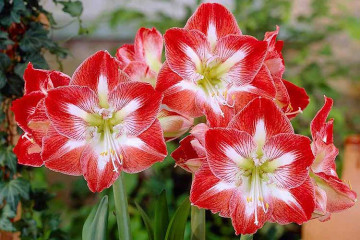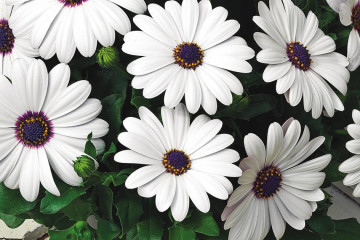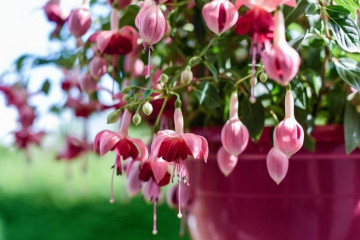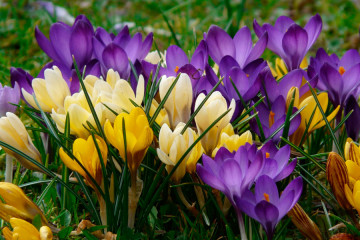Amaryllis flower - decorative varieties
Content:
The beauty and aroma of the flowers of this culture have won the hearts of many lovers of home floriculture. Amaryllis was introduced to Europe in the 18th century from South Africa, and has been widely popular among flower growers for several centuries.
Short description

Amaryllis in nature
The perennial plant of the Amaryllis family includes only the species Amaryllis belladonna.
In terms of external characteristics, it is very similar to its relative, Hippeastrum, whose homeland is the tropics and subtropics of the American continent. Hippeastrum is a flower with amaryllis-like leaves that appear before it blooms. But amaryllis is smaller in size and has the following distinctive features:
- the peduncle is more than half a meter in height, of a dense structure (in the hippeastrum it is hollow), crowned with an umbrella of large flowers in an amount of up to 12 pieces (in the hippeastrum there are up to 6 of them);
- hippeastrum is an exclusively indoor plant, amaryllis can be planted in open ground on the southern sides;
- the shape of the bulb is elongated, from 4-5 to 12-15 cm in diameter, in the hippeastrum it is flattened;
- amaryllis has a more pronounced aroma.
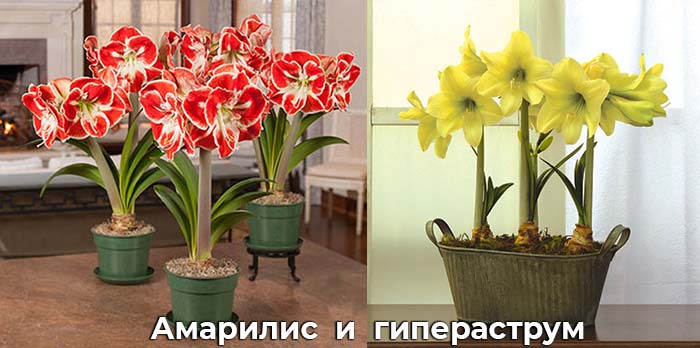
Amaryllis and hippeastrum are often confused
The alkoloid lycorin contained in the bulbs can cause poisoning.
The culture is supplied with long, up to half a meter, and narrow leaves 2-3 cm wide, having a bright color and growing in two rows. Funnel-shaped amaryllis flowers have a pleasant aroma. With optimal care, the bulb can live up to 20 years.
Ornamental flower varieties
Currently, selection is carried out in such areas as:
- Increase in the size of the peduncle, the size of the petals.
- Changing the texture of the petals (semi-double, double, super-double crops are displayed).
- Obtaining varieties with an unusual color.
- Creation of original forms of flower petals (corrugated, wavy).
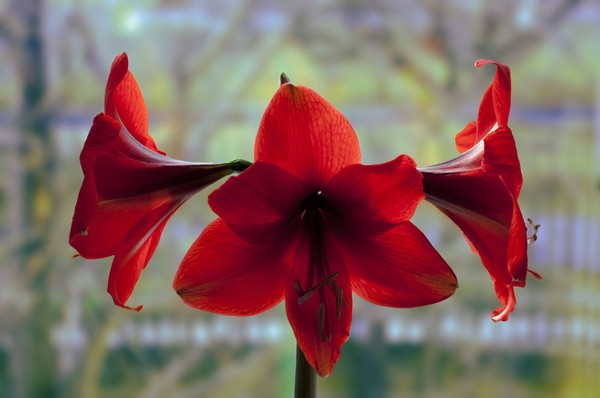
Amaryllis varieties Red Lion
The most striking varieties are:
- Amaryllis of the Red Lion variety was bred by Dutch specialists in 1958. Its green peduncle, 40-50 cm high, produces 2-4 large bright red flowers with a diameter of 16-18 cm. It blooms in winter. When the Red Lion amaryllis blooms, it never goes unnoticed.
- Amaryllis is a spectacular white variety Ice queen. It has large flowers with a creamy coating on the edges of the petals. The effectiveness of whiteness is enhanced by the gloss of the inflorescences, giving a special shine and radiance. Terry petals are elongated, not wide, sharply pointed at the ends, with wavy and corrugated edges.
- Macarena (Makarena). Culture with double bright red flowers, 6-8 cm in diameter, with white central stripes.
- Nymph. It has lush terry inflorescences that resemble peonies. A peduncle about 45 cm long produces lush 3-4 flowers with 12-14 petals up to 25 cm in diameter with wavy edges. On the creamy background of the petals, there are red strokes and stripes.
- Parker (amaryllis Parker). It has flowers of a deep purple-pink color with a yellow radiant center.
- Vera It grows up to 40 cm in height, has pale pink flowers 7-8 cm in diameter with a pearlescent tint.
- Lady Jane. Released in the USA in 1995.On a peduncle 30-55 cm high, 2-4 double flowers of salmon or orange color with white or dark orange stripes 16-20 cm in diameter grow.
- Lemon lime. Bred in 1993 in the Netherlands. On a peduncle 45-60 cm high, 3-4 flowers up to 12 cm in diameter, lemon-lime color with a wavy edge, grow. It blooms 4-6 weeks after planting, producing 2-3 peduncles suitable for cutting. After flowering, it forms many leaves 45-55 cm long and 5-6 cm wide, well-forming babies.
If you cut the flower stalks during the flowering period, they will stand for a long time in a vase of water.

Lemon-lime variety
Breeding methods
Culture propagation is done by babies, bulbs, seeds and dividing the bulb.
How to grow amaryllis from seeds at home
If the pollen of one flower is carefully transferred with a soft brush to the pistil of another at the same or another amaryllis, then the seeds will ripen in a month and a half. This is evidenced by the cracking of the seed box. The seeds are collected and planted in a container with a moistened drained soil, which consists of a 3-centimeter drainage layer, a substrate of turf, leafy earth, sand, humus. You can use a container with holes for this. In grooves 1.5 cm deep, seeds should be sown at intervals of 3-5 cm, sprinkled with a thin layer of soil. Place the container in a warm, shaded place.
Shoots appear in a month. When the seedlings form a pair of leaves, they are seated in a container of 100 ml.
Amaryllis prefers home care close to what exists in nature. Young shoots are placed in a lighted place with diffused light, a temperature of 20-25 degrees. Watering is carried out as the soil dries out 1-2 times a week. The best location of the pot is on the windows in the south, south-west and south-east directions. In order to prevent the appearance of pests and on hot dry days, you need to arrange a shower for the plant, wipe the foliage from dust with a damp swab.
It is necessary to feed the crop during the growing season once a decade, alternating mineral and organic fertilizers, for example, a 10% mullein solution and a complex fertilizer "Izumrud".
During the rest period, watering is carried out a day or two after the earth dries out by lightly moistening from a spray bottle. The plant is stored at this time in a dark and cool room (t - no more than 8 degrees), for example, in a cellar.
Amaryllis grown from seeds produces the first flower, if home care was optimal, in 5-8 years.
How to plant amaryllis with a bulb
This method is the simplest and allows you to preserve varietal characteristics. The type of pot and soil mixture for a young bulb is chosen the same as for an adult (see above conditions for growing sprouts from seeds), because the baby will quickly gain height and weight.
During the transplantation of the culture, the bulbs with the roots are separated. Choose from children those that are healthier, with strong roots. Then they are treated with a liquid fungicide or a weak solution of potassium permanganate, and the cut points of damaged areas are treated with activated carbon. They are planted in separate containers, deepening from 2/3 to half of the onion into the soil. If you bury it too deeply, the plant will not have enough strength to grow flower stalks in the future.
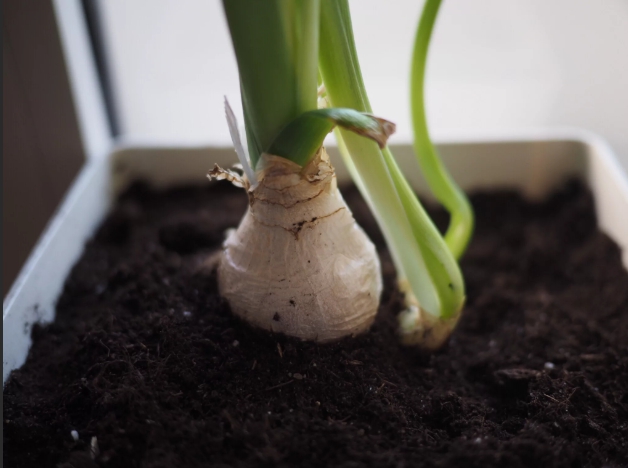
Correct burial of the bulb
Some experienced flower growers advise, after planting, watering the bulb through the pallet for the first time.
Seating by dividing the bulb
Amaryllis is a flower that can be planted by dividing a large bulb. This requires the presence of several old scales and a piece of the bottom in each lobe.The sections are sprinkled with an antiseptic (activated carbon, ash). The soil should consist of a mixture, as for an adult, and include turf, leafy soil, peat, humus, sand, with the addition of ash.
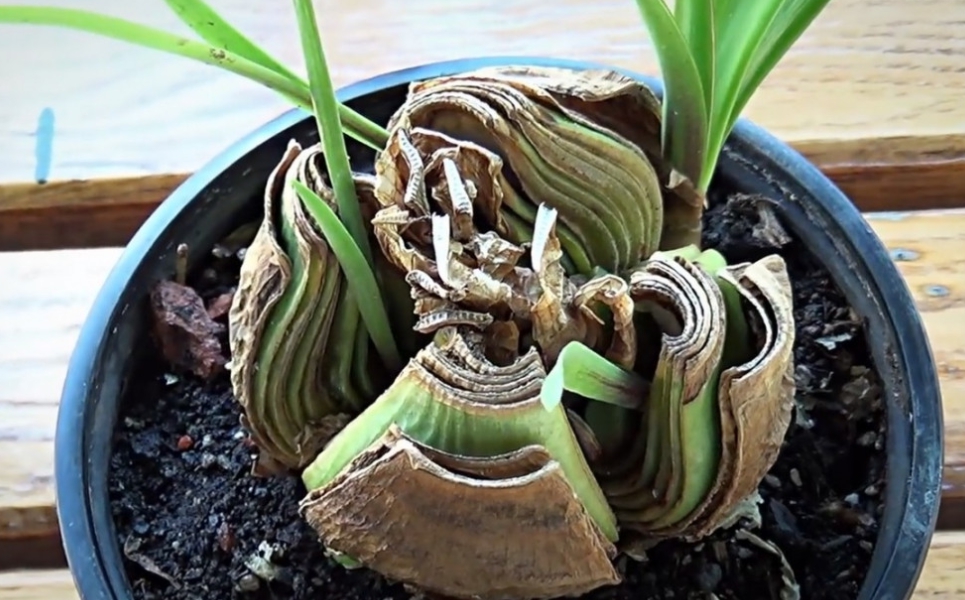
Reproduction by dividing a large onion
The first leaves will appear in a month, with the appearance of the second lobes of the bulb, it is time to plant.
Pot transplant
The optimal frequency of transplantation is once every 2-5 years. If the owner needs to control the condition of the bulbs, an annual transplant is possible, if there is no need for this, just renewing the top layer is enough.
The transplant is carried out in the spring, immediately after the plant has faded and the peduncle withers.
A few days before transplanting, you need to moisten the soil so that later it is possible to easily separate the bulb from the earthen coma. It will need to be cleaned of damage, decaying parts and treated with an antiseptic. Children should be separated.
The pot for the plant is chosen not so much as wide as deep (at least 20 cm high), because the bulb grows long roots. The distance between the wall of the pot and the bulb should not exceed 2-3 cm.
When transplanting, the diameter of the new pot may not be more than a couple of centimeters of the previous one. At its bottom, drainage is laid out in a layer of 1-3 cm, which is then covered with sand and soil.
Problems associated with growing a plant
It is necessary to take care of the flower, strictly observing the conditions of detention, corresponding to its natural habitat. If this is not ensured, then you can get the following problems:
- Blanching of flowers. Indicates the negative effects of direct sun, and their darkening - of dampness and cold.
- If the foliage and flowers are drooping, it means that there is not enough watering for the plant.
- Lack of flowering. Caused by a violation of the conditions of detention (no rest period, lack of light or feeding, too cold). If the bulb is too young or too old, too deep, this can also cause a lack of flowering.
Diseases and pests
Pests can settle on the underground and above-ground parts of the plant. The amaryllis worm is a white parasite that reproduces under the scales of the bulb. Because of it, the plant loses its growth and leaves. The remedy is insecticides.
The onion mite lives in the soil and feeds on the pulp of the bulbs. From this, the leaves of the plant turn yellow, the flowers become smaller. In this case, it is necessary to lower the air temperature and soil moisture.
The mealybug reproduces on leaves and stems and appears as fluffy white spots. A damp wipe will help fight this parasite.
The false shield, which leads to the formation of brown spots on the foliage and the shield on the flowers, is removed with soap solutions or insecticides.
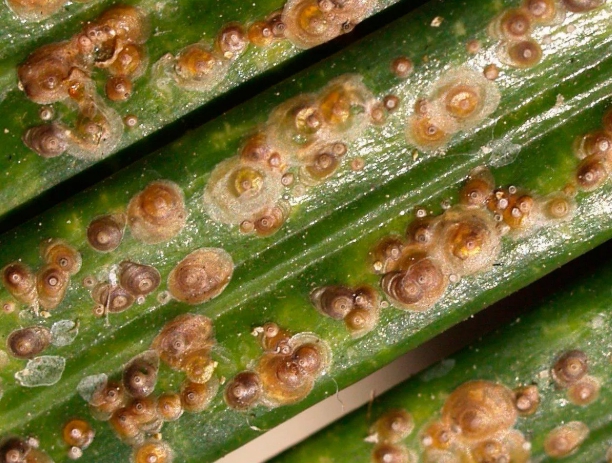
Damage from parasites
In case of damage caused by fungal diseases, for example, fusarium in the form of root rot or staganosporosis in the form of reddening of the bulbs, the plant must be isolated, removed from it the affected areas, treated with fungicides and planted in new soil.
Growing this crop is not so difficult. Blooming amaryllis, if timed for planting and leaving on a specific date, can become a valuable gift for a significant life event of a friend or colleague, decorate a house. A wide range of colors, surprisingly similar to lilies, but possessing unique decorative qualities, will satisfy the most demanding taste.
